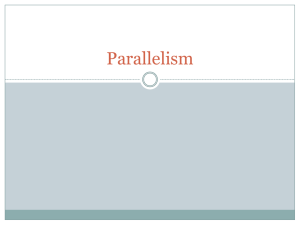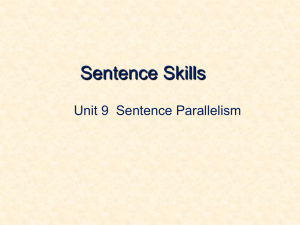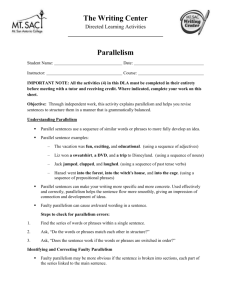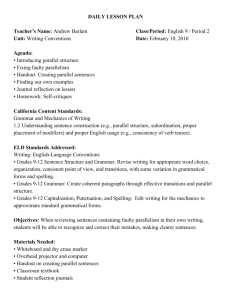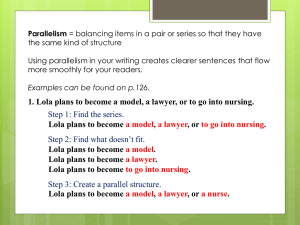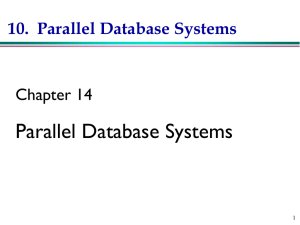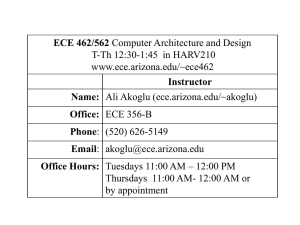parallel - Amazon Web Services
advertisement
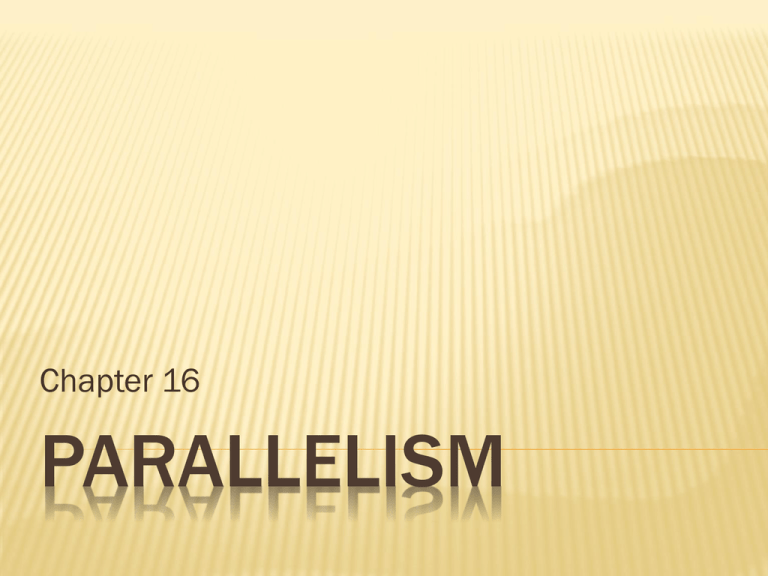
Chapter 16 PARALLELISM WHAT IS PARALLELISM ? Definition: - Using the same pattern of words. - In grammar, parallelism, also known as parallel structure or parallel construction, is a balance within one or more sentences of similar phrases or clauses that have the same grammatical structure. USE PARALLELISM By balancing the items in a sentence, you will make the sentence clearer and easier to read. Two or more equal ideas should be expressed in parallel, or matching, form. The ideas will be then read smoothly and naturally. EXAMPLES Compare the following examples: Lacking parallelism: (unbalanced) She likes cooking, jogging, and to read. Parallel: She likes cooking, jogging, and reading. In the above example, the first sentence has two gerunds and one infinitive. To make it parallel, the sentence was rewritten with three gerunds instead. Lacking parallelism: (unbalanced) The dog ran across the yard, jumped over the fence, and down the alley he sprinted. Parallel: The dog ran across the yard, jumped over the fence, and sprinted down the alley. USES OF PARALLELISM: To coordinate elements in a series To pair ideas To organize lists USING PARALLELISM All items listing two or more words, phrases, or clauses, need to be written in the same grammatical structure. For example, balance a noun with a noun, a phrase with a phrase, a clause with a clause. Many people are interested in combat when they read about it at home, study about it in school, or watching it on television. Correction: Many people are interested in combat when they read about it at home, study about it in school, or watch it on television. FAULTY PARALLELISM: items in a series appear in parallel grammatical form: a noun is listed with other nouns, an ing form with other -ing forms, and so on. Failure to express such items in similar grammatical form is called faulty parallelism. FAULTY PARALLELISM: Tourists enjoy viewing air shows on military bases and to examine displays of armor in museums. Correction: Tourists enjoy viewing air shows on military bases and examining armor displays in museums. WHEN TO USE PARALLELISM ? Parallelism always applies to two or more equal ideas. 1-With elements joined by coordinating conjunctions, especially and, but, and or. WHEN TO USE PARALLELISM ? 2- Use parallel structure with elements in lists or in a series. ( A series is a group of three or more elements in a row.) WHEN TO USE PARALLELISM ? 3- Use parallel structure with elements being compared. (X is more than / better than Y) When we compare things, we often use words such as more, less, better, and worse, We connect the items being compared with words like as and than. WHEN TO USE PARALLELISM ? 4- Use parallel structure with elements joined by a linking verb or a verb of being. EXERCISE : FAULTY PARALLELISM 1- Learning a new language as an adult is more difficult than to learn one as a child. A- learning. B- to learning. C- no change. EXERCISE : FAULTY PARALLELISM 2- Every morning, I run two miles, walk one mile, and half a mile on the bike. A- half a mile. B- bike half a mile. C- no change EXERCISE : FAULTY PARALLELISM 3- There are two ways to get a promotion: working hard or make friends in high places. A- work hard. B- to working hard C- no change EXERCISE : FAULTY PARALLELISM 4- The man walked down the street, stopped at a shop window, and fixed his tie. A- was fixing his tie. B- to fix his tie. C- no change EXERCISE : FAULTY PARALLELISM 5- Many college students have the same goals: playing hard, doing well in classes, and a job after graduation. A- after graduation, a job. B- finding a job after graduation. C- no change EXERCISE : FAULTY PARALLELISM 6- The bedroom was filled with old newspapers and radios that don’t work. A- radios that are broken B- broken radios C- no change
